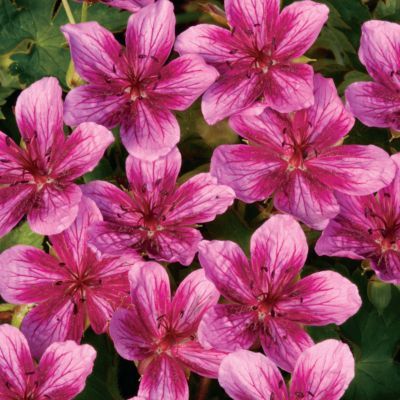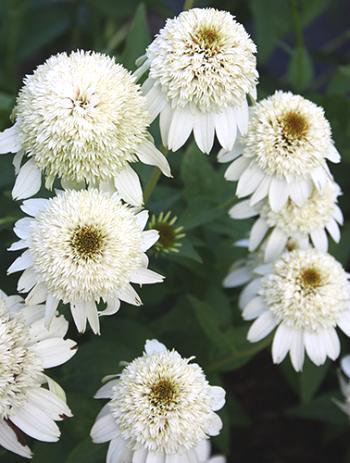One of the best ways to expand your knowledge of flowers is to listen to people who do plant trials. They get all of the new plants, treat them all the same, and see how they survive and produce.
Richard Hawke is plant evaluation manager at the Chicago Botanical Garden, and he presented the results on echinacea, perennial geranium, stachys (commonly called lamb’s ears or betony) and thalictrum (meadow rue) during a lecture at New England Grows in Boston in February. It is finally warm enough to start planting, so I thought I would give you the results now.
The most important part of the trial is a plant’s durability.
“It doesn’t matter how pretty the plant is if it isn’t going to survive,” Hawke said.
Truer words were never spoken.
Hawke said the test garden has a clay-loam soil with a 7.4 pH, which is less acidic than you would find in Maine, and that the plants receive no fertilizer or chemicals.
The trials run for a minimum of four years, but went to seven years for baptisia (another trial he is running), because it takes so long for them to get established. They are watered, and half of them dead-headed to see if that makes any difference.
New echinaceas, or coneflowers, are introduced all the time, and there is a good reason for that.
“Coneflowers are incredibly promiscuous,” Hawke said. “If you have a lot of coneflowers in your garden, you are going to get a lot of different kinds of seedlings. It is not that hard to come up with a new coneflower, but it is hard to make it right.”
He said in the last couple of years, there has been a great improvement in echinaceas, with the latest of them being a marriage of a great flower and a great plant.
Hawke believes “Pica Bella” is the best pink echinacea. It has been grown for eight years in the trial garden, so you know it will survive.
“It has boat-shaped petals, an upright habit that stays upright, a strong stem and a strong basal mound of foliage,” he said.
For the other pinks, “Pink Meadowbrite” has upright facing flowers, which is a positive, and is drought tolerant. “Pink Double Delight” is downgraded for having a week stem, but wins for flower power.
Hawke said white coneflowers get little respect, but there are some great ones.
” ‘Milkshake’ is one of the best coneflowers — not just one of the best whites, but one of the best,” he said.
Hawke said that in a storm with 80 mph winds, almost every flower in the garden went horizontal, but “Milkshake” barely even moved, and stayed upright.
He also likes “Kim’s Mop Head” with some green in the cone, a dwarf plant at only 16 inches.
As a matter of taste, he likes orange and red echinaceas because they draw his eye.
” ‘Marmalade’ is one that everyone stops to look at,” he said. “It has a big, bold bloom.”
Hawke said cranesbills, perennial geraniums, had been dominated by “Johnson’s Blue” for years and then by “Rozanne,” but there are some new varieties.
He said “Brookside” doesn’t have as strong a flower as “Johnson’s Blue,” but it is more upright and doesn’t flop around. He noted that it becomes very tall in his home garden. He prunes it after it flowers, and sometimes it will rebloom.
Hawke said Fine Gardening magazine called “Starman” the best of the best. It has pink and purple flowers, grows in full to part shade, and has a distinctive marking on the petals.
With stachys, the flower is secondary to the foliage, Hawke said.
And with a plant like “Big Ears,” which rarely flowers, the flowers sap the energy of the plant so the leaves don’t look as good. “Pink Cotton Candy” is a stachys that is grown for its flowers, which are a two-tone pink and one of the best in the trials.
“I’ve never met a meadow rue that I didn’t like,” Hawke said when he began the section of the talk on thalictrums. He loves their flowers, and the foliage is handsome.
Thalictrums have two types of flowers: Some have fairly prominent petals with a mass of stamens in the center, and others have just stamens and no petals — even though some have modified stamens called “sepals” that look like petals.
Hawke said “Black Stockings” is a good plant, but not as dark as the marketing says it is.
“Elin” is a great thalictrum that grows to 8 feet tall and has round flower buds and modified tepals, Hawke said. The foliage is purple when it first comes out of the ground and then turns bluish-green, and the foliage is so thick, you can’t see through it, he said.
He wanted to love “Splendide” for its superb flower production, but he couldn’t get it to stand up.
Thalictrum rochebruneanum is a great plant, with the same flowers as “Elin” and as prolific, but you can see the flowers through the leaves.
These are all fairly new plants, but at least you know they have gone through trials.
Tom Atwell has been writing the Maine Gardener column since 2004. He is a freelance writer gardening in Cape Elizabeth and can be contacted at 767-2297 or at:
tomatwell@me.com
Copy the Story Link
Send questions/comments to the editors.




Success. Please wait for the page to reload. If the page does not reload within 5 seconds, please refresh the page.
Enter your email and password to access comments.
Hi, to comment on stories you must . This profile is in addition to your subscription and website login.
Already have a commenting profile? .
Invalid username/password.
Please check your email to confirm and complete your registration.
Only subscribers are eligible to post comments. Please subscribe or login first for digital access. Here’s why.
Use the form below to reset your password. When you've submitted your account email, we will send an email with a reset code.